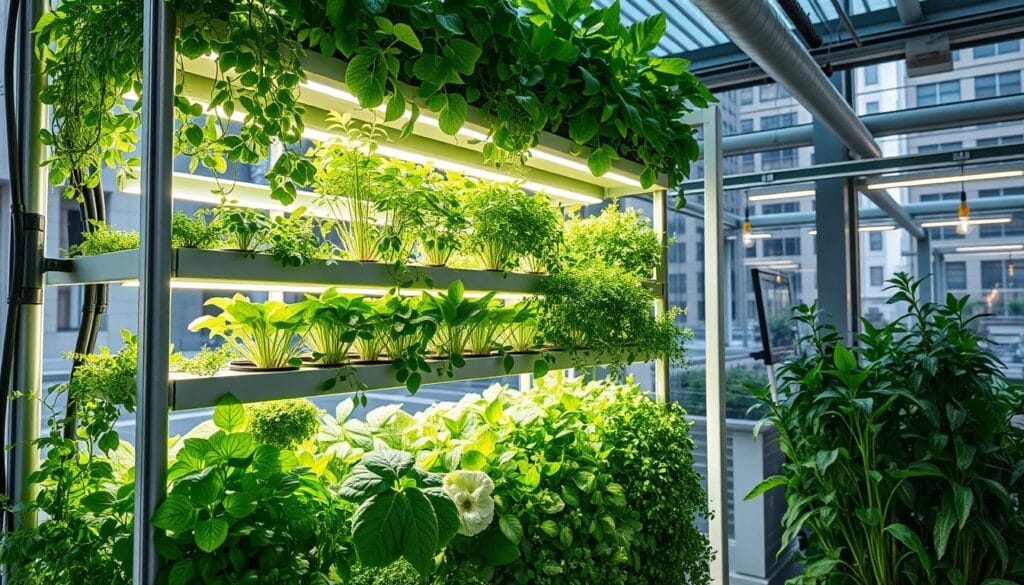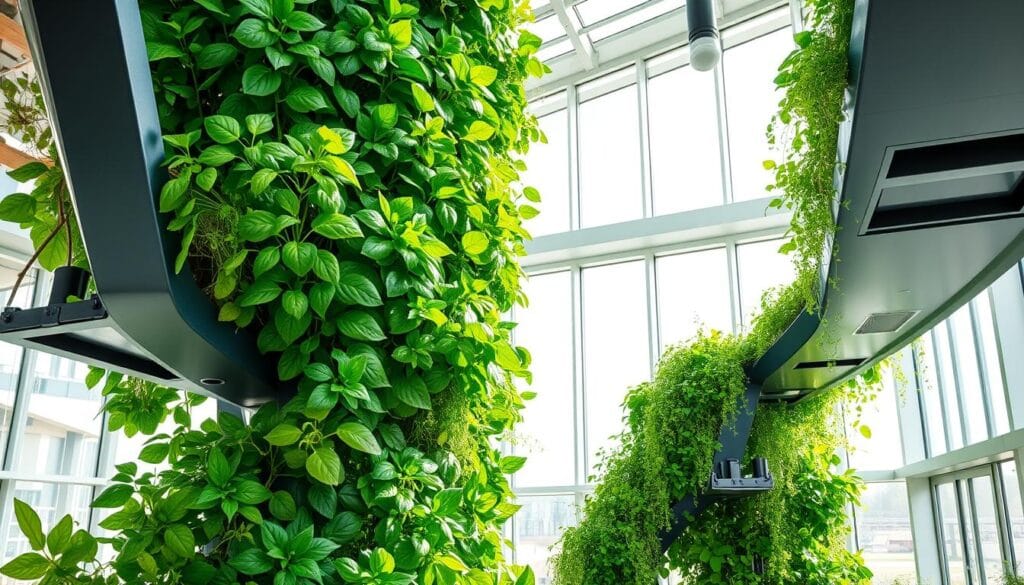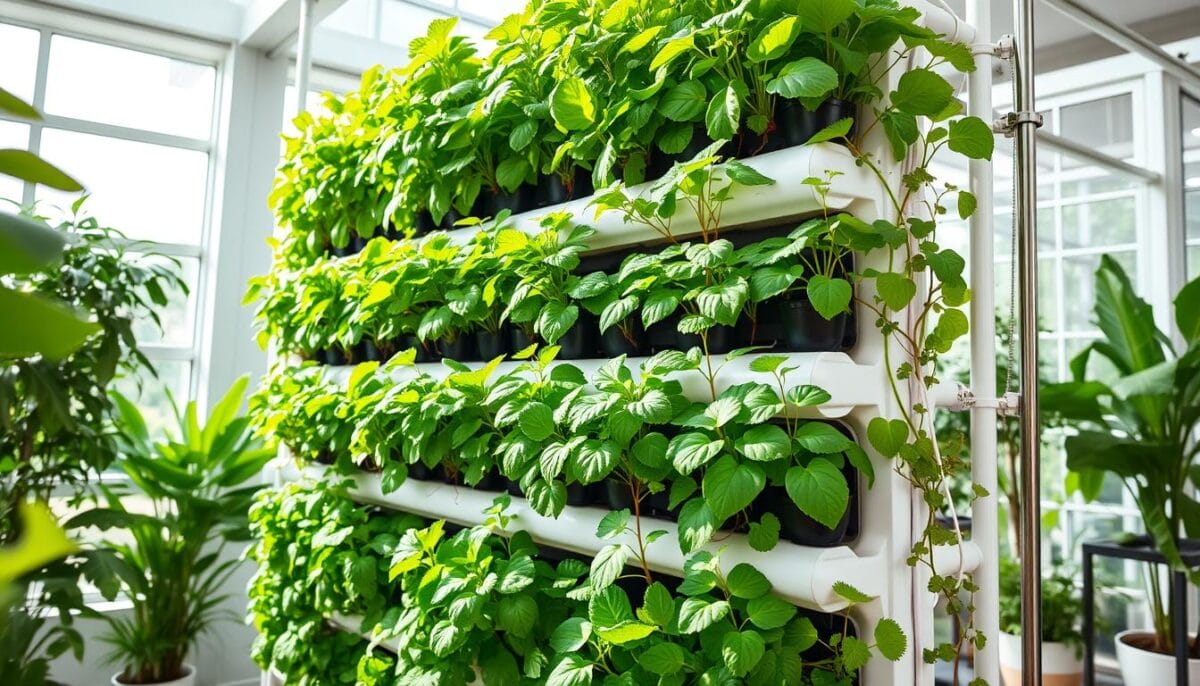Imagine fresh herbs and leafy greens on your balcony or juicy strawberries in your kitchen. Vertical hydroponics makes these dreams come true! This method lets you grow more hydroponic vertical garden, diy tower garden, diy hydroponic tower, diy vertical hydroponic garden, diy aeroponics tower plants in small spaces.
Plants grow without soil, their roots in a nutrient-rich water solution. This means faster growth, healthier plants, and more yields. Plus, you can build your own diy hydroponic tower at home with basic materials and DIY skills.
Key Takeaways
- Vertical hydroponics allows you to grow more plants in less space.
- Plants grow faster and healthier without soil, with their roots in nutrient-rich water.
- You can create your own diy vertical hydroponic garden with simple materials and DIY skills.
- Vertical hydroponics opens up exciting possibilities for urban gardeners with limited space.
- Hydroponic systems can use up to 90% less water than traditional soil-based gardening.
Introduction to Vertical Hydroponic Gardening
Imagine growing a vibrant garden right in your home. Vertical hydroponic gardening makes this dream come true. It changes how we grow fresh, healthy food. You can grow more plants in less space, perfect for small areas.
Imagine Fresh Vibrant Herbs and Leafy Greens Flourishing in Your Home
Vertical hydroponic gardening lets you have a lush garden at your fingertips. Plants grow in a nutrient-rich water solution, not soil. This means faster growth, healthier plants, and more yields in less space.
The Innovative Gardening Method for Growing More Plants in Less Space
Vertical hydroponic systems fit any space, from small to large. They use vertical space to grow more plants. This method also leads to higher yields and faster growth than traditional farming.
Using vertical hydroponics turns your home into a food production center. It reduces your need for outside food sources. Start your journey to growing excellence indoors.
“Vertical farming can use 98 percent less water and 99 percent less land compared to traditional farming methods.”
Choosing Your Vertical Hydroponic System
Setting up your diy vertical hydroponic garden means picking the right system for you. You might want a space-saving Nutrient Film Technique (NFT) system or a cool diy aeroponics tower. There are many choices to think about.
NFT (Nutrient Film Technique)
NFT systems have plants in angled channels. A thin film of nutrient solution flows along the bottom. This keeps plants close together and saves space.
ZipGrow Towers
ZipGrow Towers are vertical, with pockets for plants. Nutrient solution flows from the top down. This ensures plants get all they need to grow well.
Stacked Systems
Stacked systems are great for small spaces. Plants are in vertical containers, like buckets or PVC pipes. You can build your own frame to fit your space.
Choosing the right vertical hydroponic system is important. It should fit your space, budget, and gardening dreams. With the right setup, you can have a thriving diy vertical hydroponic garden at home.
Building Your Vertical Hydroponic Garden (Stacked Bucket System)
Ready to start with vertical hydroponic gardening? The stacked bucket system is a great choice. It’s affordable and lets you grow a lot of plants. You can grow fresh herbs, leafy greens, and more.
Materials List
- Food-grade buckets (5-gallon or larger)
- Net pots or mesh pots
- Growing medium (e.g., coco coir, perlite, or a hydroponics-specific blend)
- Submersible water pump
- Tubing
- Bulkhead fittings
- Reservoir
- Hydroponic nutrients
Step-by-Step Instructions
1. Start by drilling holes in the bottom of the buckets. This is for drainage and plumbing.
2. Next, put the net pots or mesh pots in the bucket openings. Make sure they fit well.
3. Connect the tubing from the water pump to the bottom of each bucket. Use bulkhead fittings to keep the system closed.
4. Set up the reservoir. Fill it with water and hydroponic nutrients.
5. Plant your seeds or seedlings in the growing medium inside the net pots.
Customization Tips
To make your diy tower garden or diy hydroponic tower even better, try these ideas:
- Use different sized buckets for plants of different heights and growth habits.
- Build a simple support to hold the buckets securely.
- Add an airstone to the reservoir for more oxygen for the roots.
With the stacked bucket system, you’re on your way to a thriving diy tower garden or diy hydroponic tower. Grow your own fresh produce at home and feel the joy of it!
Setting Up and Maintaining Your Vertical Garden
To grow a healthy hydroponic vertical garden, you need to know what your plants need. This includes the right growing conditions. Whether you’re making a diy vertical hydroponic garden or buying one, the basics are the same.
Choosing Plants
Vertical gardens are great for leafy greens, herbs, and some fruits like strawberries. Pick plants that don’t grow too big. Most need 6 hours of sunlight a day. Use grow lights if your garden doesn’t get enough natural light.
Lighting
Good lighting is key for a hydroponic vertical garden. Some plants like shade, but most need lots of sunlight or grow lights. Get high-quality grow lights for your plants to grow well.
Nutrient Solution
Use a hydroponic nutrient solution made for your plants. Check the pH and EC of the solution often. Adjust it as needed to keep your garden healthy.
Maintenance Tips
- Refill the reservoir with fresh nutrient solution as needed
- Change the nutrient solution to keep nutrients fresh
- Clean the growing media and parts to stop algae and debris
- Check for pests or disease and fix problems fast
- Prune plants to keep them looking good
By taking care of your diy vertical hydroponic garden, you’ll get a lot of food and a beautiful space.
Troubleshooting Common Problems
Starting a diy aeroponics tower project can be exciting and sometimes tricky. Even with careful planning, issues can still arise. Quickly solving these problems helps keep your plants healthy and your system working well.
Insufficient Lighting
Leggy plants often mean they’re not getting enough light. Try boosting the light’s intensity or how long it’s on. Good lighting is key for your diy aeroponics tower plants to grow well.
Watering Woes
Wilting plants can show you’re watering too little or too much. Keep an eye on soil moisture and modify your watering routine accordingly. Keeping your plants hydrated is vital for your vertical garden’s success.
Pest Infestations
Pests like aphids or spider mites can harm your diy aeroponics tower plants. Use safe pest control methods to keep them away. This helps keep your garden healthy.
Clogging and Algae Growth
Clogged lines can stop water flow, and algae in the reservoir can hurt your system. Clean and upkeep your diy aeroponics tower regularly. This prevents problems and keeps your system running well.
By tackling these common issues early, you can grow a thriving vertical garden. With some troubleshooting and effort, your diy aeroponics tower will give you a great harvest.
Advanced Options and Upgrades
As you get better at your hydroponic vertical garden, you can try new things. Upgrades and refinements can make your growing experience even better. Automation is a great option that saves time and keeps your plants healthy.
Automation
Use timers to control your water pump and lights. This way, your plants get the right amount of water and light. You won’t have to do it all by hand every day. Automation lets you have more free time while your diy tower garden grows well.
Sensors
For better nutrient control, add pH and EC sensors to your system. These sensors watch your nutrient solution all the time. You can adjust as needed. You can even link them to pumps for automatic nutrient control.
Different Systems
After learning the basics, try different systems. Look into NFT systems or ZipGrow towers. You could even mix different methods to find the best fit for you.
Trying these advanced options can really boost your hydroponic vertical garden. It can make your growing experience even better and open up more possibilities for diy tower garden fans.

Expanding Your Knowledge
As you explore diy hydroponic tower and diy vertical hydroponic garden, you’ll find endless learning opportunities. Look for online resources, forums, and books on hydroponics. They will help you grow your passion and gardening skills.
Joining online communities can connect you with others who love hydroponics. You can share tips, solve problems, and find new ways to garden. Check out Reddit’s r/Hydroponics or forums for vertical gardening to get involved.
Books on hydroponics can also be very helpful. They offer deep insights into plant science, nutrient management, and system design. This knowledge will help you make smart choices for your diy vertical hydroponic garden.
As you learn more, your skills and confidence will grow. Experimenting and learning will prepare you to improve your hydroponic setup. You’ll be able to solve problems and explore new possibilities in gardening.
“The more you know, the more you grow.” – Anonymous
Keep exploring and let your love for diy hydroponic tower and diy vertical hydroponic garden lead you to success. The field of hydroponics is always changing. With every new discovery, you’ll find more ways to grow and succeed.
The Joys of Hydroponic Vertical Garden
Starting a hydroponic vertical garden opens up a new world of gardening. With some creativity and care, your plants will grow upwards, making your space green and productive. The fun of vertical gardening comes from the tasty harvests and the learning journey.
Vertical gardening has been around since the 1970s. Now, it’s a big trend in cities. A hydroponic vertical garden can block out noise and make your office greener. In cities, it can even cool down the air, making your space more comfy.
Don’t be shy to try new things and see how your plants do. You can grow everything from ivy to veggies like cress and radishes. Herbs like chives, rosemary, and lavender do well, and you can even grow zucchini, tomatoes, and flowers.
Hydroponic vertical gardening is easier and makes plants grow faster and stronger. It lets you grow more in less space, cutting down on waste and transportation. It’s a green way to enjoy fresh food right at home.
Let your creativity shine with hydroponic vertical gardening. With a bit of experimentation, you’ll get a lush, productive, and beautiful garden. It will add joy to your daily life.
Eco-Friendly and Sustainable Hydroponic Systems
Hydroponic vertical gardening is a green way to grow your food. It uses much less water than regular gardening. This is an ideal choice for those passionate about making a positive impact on the planet.
Hydroponic tower systems can save up to 90% of water compared to soil gardening. They’re perfect for city living or small spaces. Growing your own food at home cuts down on carbon emissions from long-distance food transport.
Eden Green Technology is a leader in green hydroponic farming. Their greenhouses use 98% less water, 90% less light energy, and 85% less food miles than old farming ways. They also give up to 10% of their harvests to local nonprofits to fight hunger.
“Vertical farms can reduce labor costs by about 30% compared to traditional farms.”
Hydroponic vertical gardening is good for more than just the planet. It grows food without harmful chemicals. This means your food is safe and healthy. Plus, you get to enjoy fresh produce all year.
Whether you’re new to gardening or have lots of experience, hydroponic vertical gardening is a smart choice. It lets you grow more in less space while being kind to the environment. Get ready to enjoy fresh, healthy, and green homegrown food.
Growing Mediums for Indoor Vertical Gardens
Setting up your diy tower garden or diy vertical hydroponic garden means picking a growing medium. Soil-based systems are easy and affordable. But, hydroponic systems without soil can make plants grow faster and yield more, as roots get nutrients directly.
Soil-Based Systems
Soil-based vertical gardens are great for beginners. They’re familiar and need less special knowledge. These systems are cheaper and easier to care for, perfect for starting your indoor garden journey.
Hydroponic Systems
Hydroponic methods like Nutrient Film Technique (NFT), ZipGrow Towers, and Stacked Systems are efficient and save space. They grow plants indoors without soil. Plants get nutrients directly, growing faster and healthier. Setting them up might be harder, but they offer year-round harvests and are eco-friendly.
Choosing between soil-based and hydroponic systems depends on your experience, budget, and plant needs. Think about the pros and cons of each to find the best fit for your indoor garden.
DIY vs Pre-Made Vertical Garden Kits
When it comes to growing a thriving vertical hydroponic garden, you have two main options. You can build a custom DIY setup or choose a pre-made vertical garden kit. Each option has its own benefits, and the right choice depends on your needs, budget, and DIY skills.
If you enjoy hands-on projects, building a DIY diy hydroponic tower or diy aeroponics tower can be very rewarding. By making your own vertical garden, you can tailor it to fit your space, plant choices, and personal style. This is especially helpful if you have unique needs for your growing area.
| DIY Vertical Garden | Pre-Made Vertical Garden Kits |
|---|---|
|
|
Pre-made vertical garden kits, on the other hand, provide a simpler solution. They come with everything you need, from the growing structures to the irrigation systems. This makes setting up your garden much easier. It’s great for those with little DIY experience or who are short on time. Plus, many kits are designed for small spaces, perfect for city living.
In the end, whether to go for a DIY diy hydroponic tower or a pre-made kit depends on your preferences, budget, and growing space needs. By weighing the pros and cons of each, you can choose the best way to grow a thriving vertical hydroponic garden that suits you.
Top Vertical Gardening Systems to Consider
Several top systems are great for hydroponic vertical gardening. They make growing herbs, greens, and veggies easy, even in small spaces. These setups are perfect for both indoor and outdoor areas.
The Lettuce Grow Farmstand is a favorite. It’s a self-watering, self-fertilizing garden that holds up to 36 plants. Its modern design and smart tech make caring for your garden simple.
The Rise Gardens line is also popular. It has modular, stackable towers that fit any space. These gardens use AI to check on your plants and give them the right nutrients.
If you like to DIY, try the Gardyn system. It’s a kit for a hydroponic garden that lets you grow up to 30 plants. You can design your garden just how you want it.
These kits might cost more upfront. But they make starting your garden easy. You’ll get to enjoy fresh, healthy food from your own garden.

Conclusion
Hydroponic vertical gardening opens up a world of possibilities, even in small spaces. It lets you grow more plants with less water and space. Your home can become a lush, productive oasis.
Building your own system or using a kit, the fun is in learning and watching your plants grow. This journey is rewarding.
Exploring hydroponic vertical gardening reveals many benefits. It improves air quality and looks great, adding to biodiversity. This method is changing how we grow food, especially in cities.
With new technologies, like automated systems, hydroponic gardening is set to grow. It’s becoming a key part of our sustainable future.
Start growing your skills and enjoy fresh produce from your hydroponic garden. The possibilities are endless, and the rewards are great. This innovative method can make your small space vibrant and sustainable.

